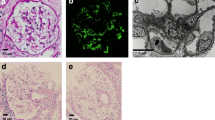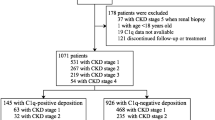Abstract
Background
C1q nephropathy is a relatively rare glomerulonephritis characterized by dominant mesangial deposition of C1q. Even though C1q nephropathy has been described for more than three decades, the clinicopathological features and renal outcomes remain unclear. C1q nephropathy may present diverse morphological patterns, including focal segmental glomerulosclerosis and, the notion of C1q nephropathy as a separate disease entity is still debated. This study aimed to describe the clinical and prognostic relevance of C1q nephropathy in children with primary focal segmental glomerulosclerosis.
Methods
Three hundred eighty-nine children were diagnosed with primary focal segmental glomerulosclerosis in Jinling Hospital from 2003 to 2020. Among them, 18 cases fulfilled the criteria for C1q nephropathy. We then selected as a control group 18 children with primary focal segmental glomerulosclerosis without C1q nephropathy matched to those with C1q nephropathy for age, sex, and period of renal biopsy. Clinical and prognostic parameters were compared in children with and without C1q nephropathy. Renal end-point was defined as a ≥ 40% reduction in estimated glomerular filtration rate or end-stage renal disease.
Results
Four point sixty-three percent (18/389) of primary focal segmental glomerulosclerosis cases were diagnosed with C1q nephropathy. The male-to-female ratio of patients diagnosed with C1q nephropathy was 1:1. The median age at biopsy and age at onset was 15.63 (13.00–16.50) years and 14.50 (9.00–16.00) years, respectively. The prevalence of nephrotic syndrome, hematuria, and hypertension was 38.90% (7/18), 72.20% (13/18), and 33.30% (5/18), respectively. Four (22.2%) patients were steroid-dependent, 13 (72.2%) patients were steroid-resistant, and 1 (5.6%) patient developed secondary steroid-resistance. During a follow-up of 52.24 (25.00–72.47) months, 10 (55.6%) patients achieved remission, and 5 (27.8%) progressed to the end-point [including 2 (11.11%) patients who developed end-stage kidney disease]. There was no significant difference in the estimated end-stage renal disease-free survival rates, the estimated end-point-free survival rates, and the long-term remission rate between patients with and without C1q nephropathy (Kaplan–Meier, Log-rank, all P > 0.05).
Conclusions
C1q nephropathy was rare in pediatric patients with focal segmental glomerulosclerosis. These patients usually had poor response to steroids. The long-term renal outcomes and remission of children with primary focal segmental glomerulosclerosis with C1q nephropathy were comparable to those without C1q nephropathy.
Graphical abstract


Similar content being viewed by others
Data availability
The raw data supporting the conclusions of this article will be made available by the authors, without undue reservation.
References
Jennette JC, Hipp CG (1985) C1q nephropathy: a distinct pathologic entity usually causing nephrotic syndrome. Am J Kidney Dis 6:103–110
Devasahayam J, Erode-Singaravelu G, Bhat Z et al (2015) C1q nephropathy: the unique underrecognized pathological entity. Anal Cell Pathol (Amst) 490413:2015
Gunasekara VN, Sebire NJ, Tullus K (2014) C1q nephropathy in children: clinical characteristics and outcome. Pediatr Nephrol 29:407–413
Vizjak A, Ferluga D, Rozic M et al (2008) Pathology, clinical presentations, and outcomes of C1q nephropathy. J Am Soc Nephrol 19:2237–2244
Kersnik Levart T, Kenda RB, AvgustinCavić M et al (2005) C1Q nephropathy in children. Pediatr Nephrol 20:1756–1761
VintarSpreitzer M, Vizjak A, Ferluga D et al (2014) Do C1q or IgM nephropathies predict disease severity in children with minimal change nephrotic syndrome? Pediatr Nephrol 29:67–74
Kim K, Son HE, Ryu JY et al (2019) C1q nephropathy in adults is a form of focal segmental glomerulosclerosis in terms of clinical characteristics. PLoS ONE 14:e0215217
Schwartz GJ, Brion LP, Spitzer A (1987) The use of plasma creatinine concentration for estimating glomerular filtration rate in infants, children, and adolescents. Pediatr Clin N Am 34:571–590
Chi XH, Li GP, Wang QS et al (2017) CKD-EPI creatinine-cystatin C glomerular filtration rate estimation equation seems more suitable for Chinese patients with chronic kidney disease than other equations. BMC Nephrol 18:226
Dionne JM (2017) Updated guideline may improve the recognition and diagnosis of hypertension in children and adolescents; review of the 2017 AAP blood pressure clinical practice guideline. Curr Hypertens Rep 19:84
Trautmann A, Vivarelli M, Samuel S et al (2020) IPNA clinical practice recommendations for the diagnosis and management of children with steroid-resistant nephrotic syndrome. Pediatr Nephrol 35:1529–1561
D’Agati VD, Fogo AB, Bruijn JA et al (2004) Pathologic classification of focal segmental glomerulosclerosis: a working proposal. Am J Kidney Dis 43:368–382
Gipson DS, Troost JP, Spino C et al (2022) Comparing kidney health outcomes in children, adolescents, and adults with focal segmental glomerulosclerosis. JAMA Netw Open 5(8):e2228701
Markowitz GS, Schwimmer JA, Stokes MB et al (2003) C1q nephropathy: a variant of focal segmental glomerulosclerosis. Kidney Int 64:1232–1240
Mokhtar GA, Jalalah SM (2015) A clinicopathological study of C1q nephropathy at King Abdulaziz University. Iran J Kidney Dis 9(4):279–285
Vizjak A, Ferluga D, Rozic M et al (2008) Pathology, clinical presentations, and outcomes of C1q nephropathy. J Am Soc Nephrol 19(11):2237–2244. https://doi.org/10.1681/ASN.2007080929
Wong CS, Fink CA, Baechle J et al (2009) C1q nephropathy and minimal change nephrotic syndrome. Pediatr Nephrol 24:761–767
Lau KK, Gaber LW, Delos Santos NM et al (2005) C1q nephropathy: features at presentation and outcome. Pediatr Nephrol 20:744–749
Tibor Fülöp T, Csongrádi É, Lerant AA et al (2015) Resolution of C1q deposition but not of the clinical nephrotic syndrome after immunomodulating therapy in focal sclerosis. J Nephropathol 4:54–58
Strassheim D, Renner B, Panzer S et al (2013) IgM contributes to glomerular injury in FSGS. J Am Soc Nephrol 24:393–406
Panzer SE, Laskowski J, Renner B et al (2015) IgM exacerbates glomerular disease progression in complement-induced glomerulopathy. Kidney Int 88:528–537
Zhang YM, Gu QH, Huang J et al (2016) Clinical significance of IgM and C3 glomerular deposition in primary focal segmental glomerulosclerosis. Clin J Am Soc Nephrol 11:1582–1589
Mirioglu S, Caliskan Y, Ozluk Y et al (2019) Co-deposition of IgM and C3 may indicate unfavorable renal outcomes in adult patients with primary focal segmental glomerulosclerosis. Kidney Blood Press Res 44:961–972
Funding
This work was supported by the project of Clinical Advanced Techniques, Primary Research & Development Plan of Jiangsu Province (BE2017719), the Pediatric Medical Innovation Team of Jiangsu Province (CXTDA2017022), the Major Specialty Project of Nanjing (SZDZK2016009).
Author information
Authors and Affiliations
Contributions
YP and TJ are principal co-investigators and contributed equally to the study design and manuscript draft. All authors collected, reviewed, and analyzed the data. All authors approved the final manuscript as submitted and agree to be accountable for all aspects of the work.
Corresponding authors
Ethics declarations
Conflict of interest
All authors declare that the research was conducted in the absence of any commercial or financial relationships that could be construed as a potential conflict of interest.
Ethical approval and Informed consent
The clinical Trials Ethics Committee of the Jinling hospital reviewed and approved this study involving human participants (No. 2022DZKY-047-01). The data are anonymous, and the requirement for informed consent was therefore waived.
Additional information
Publisher's Note
Springer Nature remains neutral with regard to jurisdictional claims in published maps and institutional affiliations.
Rights and permissions
Springer Nature or its licensor (e.g. a society or other partner) holds exclusive rights to this article under a publishing agreement with the author(s) or other rightsholder(s); author self-archiving of the accepted manuscript version of this article is solely governed by the terms of such publishing agreement and applicable law.
About this article
Cite this article
Peng, Y., Ju, T., Gao, C. et al. A clinicopathological and prognostic study of 18 children with C1q nephropathy and focal segmental glomerulosclerosis: an 18-year experience from a single center. J Nephrol 36, 1615–1625 (2023). https://doi.org/10.1007/s40620-023-01679-9
Received:
Accepted:
Published:
Issue Date:
DOI: https://doi.org/10.1007/s40620-023-01679-9




